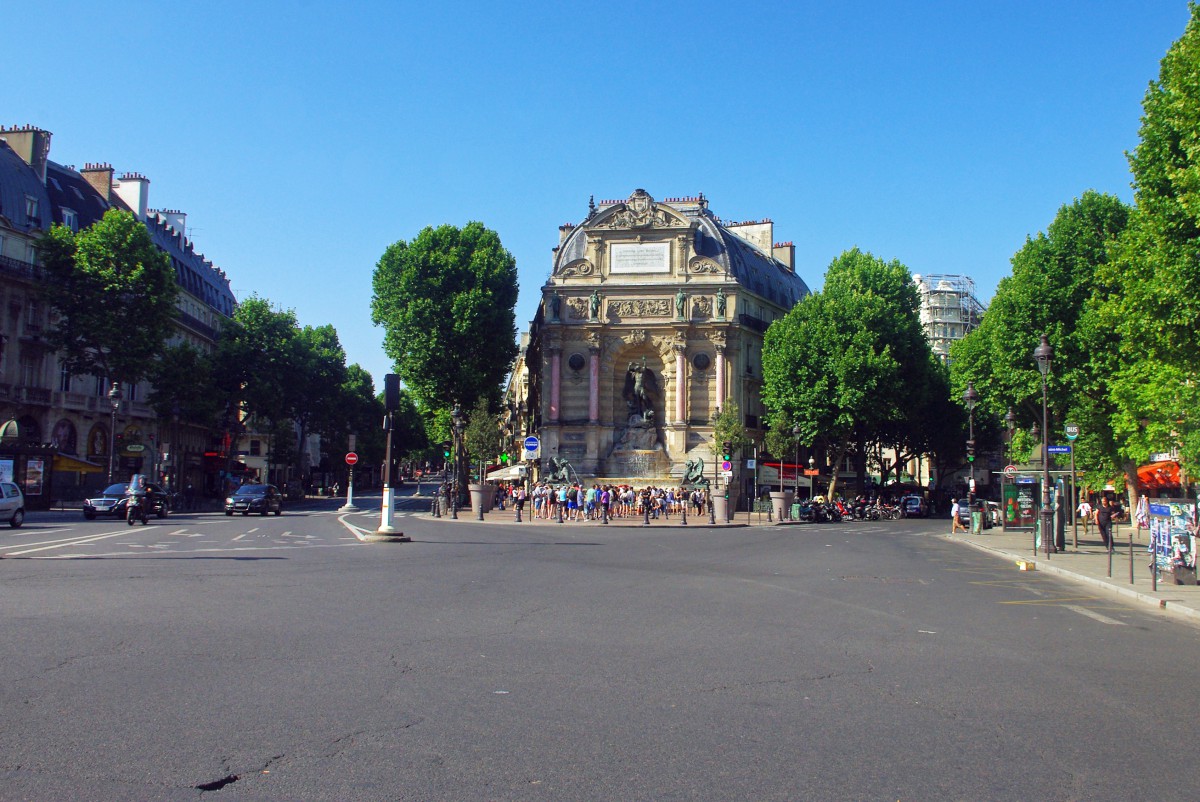There aren’t many wall fountains in Paris. The Saint-Michel fountain on the Left Bank is probably the largest. The monumental fountain is a neo-Renaissance creation from the Haussmann era in 1860. For me, the fountain has been a starting point for my excursions into the 5th and 6th arrondissements.
The Saint-Michel fountain
The monumental Fontaine Saint-Michel overlooks Place Saint-Michel, a lively square where the Boulevard Saint-Michel meets the quays of the Seine.
Click here to locate the square on Google Maps.
It was part of the great urban project planned by Baron Haussmann during the Second Empire. In 1855, the urban planner completed the boulevard de Sébastopol-rive-gauche (today’s boulevard Saint-Michel). Haussmann wanted the edification of a monumental fountain at the north end of the street facing the Île de la Cité. The little square was enlarged to become today’s Place Saint-Michel.

Architect Gabriel Davioud designed a great fountain to the scale of the new square. Davioud initially wished to build a fountain in the centre of the square. However, Haussmann and his team were not too keen on that idea. They asked the architect to place the fountain on the building at the corner of Boulevard Saint-Michel and rue Saint-André des Arts. This would impressively mask the end wall.
The fountain was inaugurated on the 15th of August 1860. At first, it did not meet the approval of many Parisians. Some did not like the fact that it was placed against the wall. Others judged it too colourful.
A brief description of the Saint-Michel fountain

The Saint-Michel fountain is 26 metres high by 15 metres wide (85 x 49 ft). Unlike other Parisian fountains, it was designed using different colours of stone. Nine different sculptors were commissioned to create the iconography of the fountain.
The Saint-Michel fountain looks like a triumphal arch with four Corinthian columns flanking the central niche. It shares similarities with Paris’ first wall fountain: the Medici fountain in the Luxembourg garden. Another wall fountain of importance is the Four Seasons Fountain, situated in the 7th arrondissement.
The four bronze statues
The columns of red marble from Languedoc are surmounted by four bronze statues representing the cardinal virtues:
- Prudence, holding a serpent and a mirror, by Jean-Auguste Barre
- Fortitude, with a lion skin and club, by Claude-Jean Guillaume
- Justice, with a scale and sword, by Louis-Valentin Robert
- Temperance, by Charles-Alphonse Guméry
The pediment
The pediment includes a frieze with neo-Renaissance bas-reliefs and rinceaux by Claude Vignon.
The main cornice is topped by a Renaissance-style pediment containing an inscribed tablet. It reads the year of dedication in Roman numerals, that is 1860.
Fontaine Saint Michel
Sous le règne de Napoléon III empereur des Français
Ce monument a été élevé par la ville de Paris
An MDCCCLX
Saint Michel Fountain
During the reign of Napoleon III, Emperor of the French
This monument was erected by the city of Paris
Year MDCCCLX
At the very top, two statues by Auguste-Hyacinthe Debay hold the coat of arms of Paris. They represent Power and Moderation.
The Archangel
The central niche is occupied by the Archangel Michael wrestling with the devil. This statue was sculpted by Francisque-Joseph Duret. The Archangel is depicted in Roman garb and is seen brandishing a sword.
The fountain’s water flows out from the artificial rock at the base of St. Michael’s statue into a series of superimposed basins. The structure overlooks a large basin at the square level.
Two winged dragons by Henri Alfred Jacquemart were placed on either side of the fountain.
More photos








- The fountain is south-orientated; therefore, you should come in the morning to photograph it better.
- The fountain is beautifully lit-up at night.
- Closest métro station: Saint-Michel (line 4, RER C).
- Read more about Place Saint-Michel on Wikipedia

Pin it for later
Did you enjoy the reading? If so, share it on Facebook and Twitter or pin it on Pinterest:





Lovely and meaningful article.
Thank you Pierre, Merci
You’re welcome! 🙂
Thank you for teaching me about this beautiful historic fountain. Delightful! Merci.
You’re welcome!